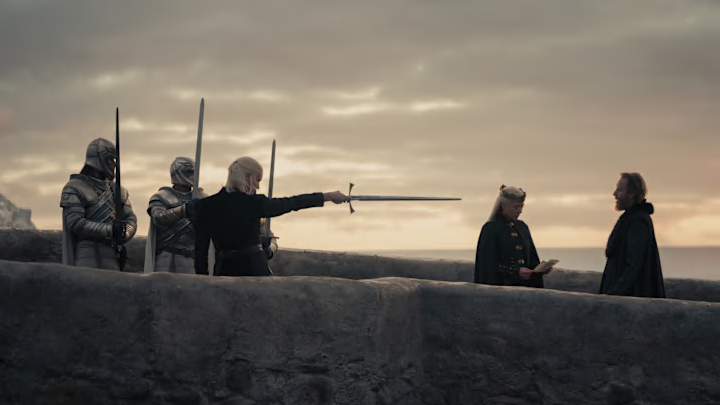Game of Thrones was a show with rich worldbuilding, complex characters, and shocking plot developments, but there's no denying part of what made it such an intriguing show was its graphic depictions of violence. When Game of Thrones first aired nearly 15 years ago, we'd come to expect bloody battles and graphic depictions of medieval war on the big screen, but on television? To watch in the comfort of our own homes? It might feel commonplace across streaming platforms now, but that was very much not the case in 2011.
Flash forward 13 years, and House of the Dragon, at face value, continues the legacy of its predecessor. There is blood. There is viscera. There is Daemon Targaryen (Matt Smith) removing a variety of body parts from a variety of humans. And yet, even in its most violent moments, House of the Dragon feels different.
The centerpiece of House of the Dragon's very first episode is a medieval tournament filled with jousting and hand-to-hand combat. The main event is a showdown between Daemon Targaryen and Ser Criston Cole (Fabien Frankel). But their duel is over quickly. Mostly we see various faceless knights attacking each other. It's at this point Princess Rhaenys (Eve Best), comments to her husband, Corlys Velaryon (Steve Toussaint), "And the day grows ugly."
The conversation that follows laments "wanton violence," and Corlys questions "if this is how we should celebrate the birth of our future king." Meanwhile, a montage unfolds that includes not just the knights mutilating one another, but a series of young people's reactions to it: a page falls to his knees, vomiting. The young Princess Rhaenyra (Milly Alcock) gasps in surprise. A very young Laena Velaryon (Nova Fouillis-Mose) becomes visibly uncomfortable. And we get our first shot of Alicent Hightower (Emily Carey) picking at her fingernails, one of season 1's most significant motifs.
To further highlight the pointlessness of so much violence and death, the tournament is cut together with scenes of Queen Aemma (Sian Brooke) dying in childbirth; the son who is torn from her dies mere hours later. For the Targaryens and the entire realm, the "celebration" of the tournament becomes a gruesome foreshadowing of bloodshed to come.
There's nothing new about the graphic content of this sequence for Game of Thrones fans. It's expected from this genre of fantasy storytelling, one which Game of Thrones helped establish. But the tone of the sequence strikes a tone the original show rarely did: just sad. Aemma dies. Her son dies. King Viserys (Paddy Considine) loses the wife he loved and the son he hoped would be his heir. Rhaenyra loses her mother. Young people are forced to witness unnecessary violence. It's pure tragedy, brought about not because of vengeance or divine justice, but impossible circumstances.
Game of Thrones vs House of the Dragon
I woudn't say Game of Thrones ever intended to glorify violence, but it certainly leveraged the spectacle of it. Yes, it was there for the sake of realism, to examine humanity's capacity for brutality, but it was also presented with a certain cool factor.
In the very first episode of Game of Thrones, the Stark children have to witness their father, Ned Stark (Sean Bean) perform an execution by beheading. As it unfolds, Jon Snow (Kit Harrington) whispers to the young Bran Stark (Isaac Hempstead Wright), "Don't look away. Father will know if you do." Once the execution is complete, we get a series of shots showing onlookers' reactions. Unlike the startled youngsters we see in House of the Dragon, everyone, including Bran, remains stoic. They barely show a clenched jaw or uncomfortable swallow. "You did well," Jon says, praising his younger brother and, in a way, the viewers. We must witness this, the script seems to say. And we did. For eight seasons.
House of the Dragon, in contrast, strips away even the spectacle of violence by making it not just uncomfortable or pointless, but deeply sorrowful. If the subtext of Game of Thrones was, 'We must witness this,' then the subtext of House of the Dragon is, 'We are sorry to witness this.'
This shift in tone toward the violence in Westeros and that permeates our own culture is fitting, since House of the Dragon is a story about House Targaryen's long, slow, tumultuous demise, one brought on by the violence of war. It also fits with our current time, when we receive daily updates about wars raging across the world and too many real people are grappling with the kind of violence we have the privilege of watching on television. The show's creators seem to be in conversations not only with the history and legacy of House Targaryen, but with the history and legacy of Game of Thrones.
Season 2 of House of the Dragon debuts this Sunday, June 16, and fans — including me — are excited for the twists and turns. There's much anticipation of a "Red Wedding Moment" that may shock and enthrall us. But I hope as House of the Dragon moves closer in time to the events of Game of Thrones, it maintains the sensitivity that, so far, has distinguished it from its predecessor.
To stay up to date on everything fantasy, science fiction, and WiC, follow our all-encompassing Facebook page and Twitter account, sign up for our exclusive newsletter and check out our YouTube channel.
